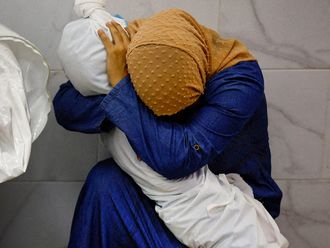London: In the catalogue it was simply Lot 216 — an ice axe. But to those who knew the story, it seemed to be mountaineering’s Excalibur, the ice axe George Mallory drove into the snow to save the lives of three companions as they fell from Everest in 1922.
In April, despite an estimate of only £8,000 (Dh47,730), Christie’s sold Mallory’s axe for £132,100 to American investor and climbing enthusiast Warren B Kanders. Yet the more experts looked at Mallory’s axe, the more questions were raised about whether it was the same one used to save his friends. There are doubts it was even made in his lifetime.
Back in the spring, leading British mountaineers lamented the export of an important artefact associated with the climber who disappeared during a final desperate assault on the summit in 1924. Kenton Cool, who has climbed the mountain 11 times, said: “This axe is a symbol of our national spirit, grit, determination and a will to succeed against the odds. I hope that the axe stays in our country, remaining on display for anyone who wants to connect with this important moment in our history.”
The sale was referred to the Arts Council for an export licence. The Arts Council declined to comment, but the Observer has learned that a licence was issued on September 3, pending a further three-week consultation process. Last Wednesday, the prized possession of one of British exploration’s most romantic figures was free to leave the country.
The story adding such lustre to Christie’s sale showed Mallory at his best. Retreating from an attempt on Everest’s summit on May 21, 1922, he was leading the way down. Close behind him were the army officer Edward Norton, explorer Henry Morshead and the surgeon Howard Somervell.
Morshead was exhausted when he fell. Somervell, anchoring their rope of four at the back, could not hold him. Norton was also plucked off the slope and the three hurtled towards the Rongbuk glacier, 3,000 feet below.
Mallory, his mind fogged with hypoxia [where the body is deprived of adequate oxygen supply], his body wearied after the effort to reach the summit, was cutting a step with his axe when he heard the sound of his comrades falling behind him. Acting on instinct, he thrust the axe into the snow and looped the rope around it, saving all their lives. According to Christie’s, Ruth Mallory, George’s widow, gave an ice axe to the Pinnacle Club, a women-only climbing group. It was then passed on to a member, Nancy Carpenter, who in her 80s gave it to her neighbours, the Threkeld family, the vendors, in April.
But when Jerry Lovatt, responsible for the Alpine Club’s artefacts and an expert witness for the Arts Council, looked closely at photographs of Everest that year, the ice axe in Mallory’s hand did not seem to be the one for sale at Christie’s. “It’s possible Mallory had two axes on the mountain,” he says, “but it seems unlikely. My best guess is that the ice axe sold in April wasn’t there.”
Then there is the name on its steel pick. Christie’s described this as I Horeschowski of Vienna. In fact, the name on the axe is Horeschowsky, probably Alfred Horeschowsky — an Austrian climber. Horeschowsky used his name to manufacture and market climbing equipment.
Yet according to archivists in Austria, the first mention of an ice axe made by Horeschowsky was in 1927, three years after Mallory’s death.
Until the 1920s, ice axes had been custom made. That of Andrew Irvine, Mallory’s ill-fated partner on his final climb, was recovered and is still in the possession of the Alpine Club. It has no manufacturer’s mark.
Jerry Lovatt believes that under Arts Council rules — the so-called Waverley criteria — protecting academic study, an export licence should only have been issued after a proper investigation. “I don’t think there’s any doubt the axe came from the Mallory home. But was it George’s? Three weeks to do a proper study isn’t enough. It seems a shame.”
In a statement, Christie’s said: “Lot 216 was sold by Christie’s as ‘an ice-axe’, on 10 April 2014. Said to have been used by George Mallory and previously exhibited as such, Christie’s catalogue description, estimate and saleroom notice reflected that we could not state with certainty that this lot belonged to or was used by Mallory.”












